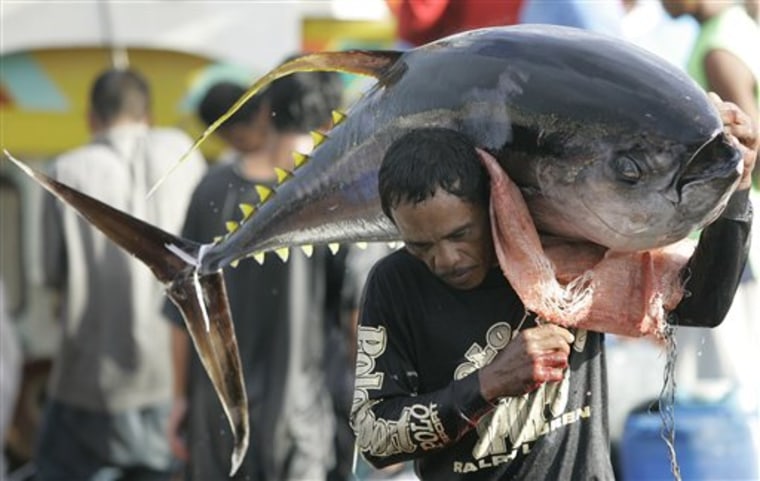Environmentalists want tougher restrictions on the industrial-scale fishing of bigeye tuna in the Pacific Ocean after new research showed current measures are failing and will do little to sustain stocks of a fish that is popular in sushi bars the world over.
The findings will intensify a debate between the multibillion dollar fishing industry and conservationists over the best ways to protect 23 tuna species, nine of which are threatened with extinction.
Bigeye and yellowfin tuna, which can grow to 8 or 9 feet long and weigh more than 450 pounds are not in immediate danger of being wiped out, but have been hit hard by overfishing. The fish are used mostly for steaks, and in the case of bigeye, sushi.
The western and central Pacific region accounts for 55 percent of the world's tuna production with a value of $4 billion to $5 billion. Tuna stocks in the region have fallen since the 1960s, driven down by increasing numbers of industrial fishing fleets.
In December, the Western and Central Pacific Fisheries Commission, which regulates commercial fishing from Indonesia to Hawaii, approved measures supposed to reduce catches of bigeye tuna by 30 percent over three years and limit catches of yellowfin tuna to 2001-2004 levels.
Protective measures undermined
But scientists working for the commission found the measures were undermined by numerous territorial exemptions from the catch limits, including coastal waters that surround archipelagic states such as Indonesia, Papua New Guinea and the Philippines.
It also found limits on purse seine fishing — an industrial technique where a net is used to surround and capture schools of tuna — are ineffective as they are based on catch rates from 2004 that were higher than average. Also, the fleet sizes allowed under the commission's limits are not those from 2004 but what each country is permitted under various treaties. In the case of the United States, that is twice as many boats as they used in 2004.
John Hampton, one of the authors of the report, said Thursday the commission's measures would only limit big eye fishing to recent "fairly high levels."
"It allows stock to fall below accepted levels that (are required for) long-term sustainability," he said. "That doesn't mean the stocks will collapse completely and go extinct. But it would be reduced to a level that would result in the stock being much less productive than it could be."
Overfishing
Environmentalists say the research shows the current restrictions are inadequate and are calling for tough and swift action by the industry to protect bigeye tuna, which are in danger of being overfished. Yellowfin are less threatened.
"The value of this assessment is that it shows the likely result on high value tuna stocks of barely adequate fishing controls that are then further weakened with loads of exemptions," said Jose Ingles, a fisheries expert for the environmental group World Wildlife Fund.
The commission's Executive Director Andrew Wright said it will meet in December to consider whether to toughen the measures or wait a year to better determine their effectiveness.
Anouk Ride, a spokeswoman for the Pacific Islands Forum Fisheries Agency, which represents 17 countries and territories including Australia and New Zealand, said her members support tougher measures, including a 40 percent cut in bigeye tuna catches.
More on: Environment
